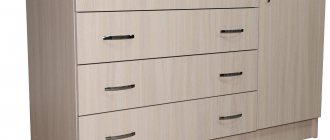Types of siphons
There are several types of siphons, which have their own characteristics, advantages and disadvantages. The most popular type is considered to be bottled. Visually, it is similar to an ordinary bottle, which is where the name comes from.
Structurally, this is the most complex model in comparison with others, but it has a number of advantages :
- compact dimensions allowing it to be installed under the sink with minimal space;
- ease of installation, assembly and disassembly for maintenance;
- if foreign objects accidentally get into the drain, they do not drain into the sewer, but settle at the bottom of the flask;
- It is possible to connect an overflow for a sink, as well as other equipment such as a washing machine or dishwasher.
A significant drawback is the accumulation of dirt in the flask. There are a lot of design options for the bottle look, one of them is the hidden type. In this case, the glass is installed in the wall, and only the tube comes out from the outside. The device is used very rarely in practice and is quite expensive.
The next popular type is pipe and corrugated. The tube design includes a rigid tube that is visually shaped like an “S” or “U”. Structurally, the equipment can be disassembled or cannot be disassembled.
Some models have a plug at the bottom that opens from time to time to clear the drain. Due to the rigidity, it is necessary to strictly follow the installation rules, and the sink drain and the entrance of the hole into the sewer must be combined as tightly as possible.
Corrugated options are more practical; if necessary, they can be bent into a convenient position, which is important for complex methods of connecting to the sewer. There are no intermediate connections in the device, so the likelihood of leakage is reduced. The slope is made mechanically by bending the tube. Installation and assembly are simple, which is an advantage. The main disadvantage is the accumulation of deposits in the flexible hose, which must be cleaned from time to time.
Other types include:
- flat - standard design, but all its parts are horizontal. Suitable for installation under a sink where there is not enough free space;
- siphon with a stream break - differs from the standard version in a small gap of up to 3 cm, which is installed between the outlet and inlet openings. Due to this, germs and other debris cannot enter the sink from the sewer pipe. These types are often used in catering establishments.
Standard equipment includes the following parts:
- metal grate under the drain, trapping debris and other large particles;
- a set of rubber gaskets of different shapes and thicknesses. In more expensive equipment they will be white;
- water drainage pipe with raised rings. Some models are equipped with a branch for additional installation of a washing machine or dishwasher;
- screws for connecting the siphon and the grille, it is recommended to choose a stainless steel element;
- frame;
- nuts;
- tubes for connecting to the sewerage system.
All construction and materials must be resistant to chemicals and high temperatures.
Plastic models are inexpensive and easy to assemble.
Polypropylene products are characterized by increased rigidity, so they retain their shape, and the fasteners are more reliable.
Stainless steel options are expensive and are rarely used, but are suitable for kitchens where there is no cabinet under the sink. It is recommended to choose bronze or brass parts with additional coating to prevent corrosion and oxides.
How does he work
The principle of operation of the siphon is based on its design feature. The lower part of the device, called a reservoir or sump, constantly contains water coming from the sink bowl. At this moment, high pressure arises in the drain - this leads to the displacement of the “old” liquid.
When the water supply stops, the pressure in the siphon equalizes. As a result, some of the liquid remains in the curved part. This water plug prevents unpleasant odors from entering the room from the sewer.
Water flows freely from the siphon and enters the sewer, and air cannot enter the room from the sewer, since the vertical pipe is located below the water level
The siphon plays another important role. Since it is installed after the kitchen sink, it is able to trap some debris. It accumulates in the sump and is easily removed by partial disassembly when removing the tank - the homeowner can carry out this procedure independently, without the involvement of a professional plumber. Preventing waste from directly entering the sewer system will prevent it from becoming clogged.
Siphon selection
When choosing a siphon for your kitchen, you need to consider several important factors. Be sure to pay attention to the following parameters before purchasing:
- the cost of the product does not depend on the quality of work, but indicates the approximate service life. The more expensive the part, the longer it will last; in addition, the price depends on the materials used to make the device;
- aesthetics is an important parameter for sinks without cabinets, when the entire space is visible. In this case, choose a chrome siphon to create the desired impression, and if you have a cabinet, then use any type;
- type of plumbing - for a standard sink, you can buy siphons of any kind, and there are no difficulties with choosing, but if the sink is made to order and has non-standard dimensions, then it is better to use corrugated or bottle types. Rigid pipe models are suitable for standard kitchen sinks;
- volume of water - depends on the planned flow of water through the sink. For frequent work, it is necessary to select pipes with an increased diameter, otherwise liquid may overflow into the room, which leads to flooding;
- the presence of an overflow will help protect the kitchen from flooding;
- diameter of the sink and sewer drain - if the values deviate from the standard ones, then additional adapters should be purchased.
- additional drain - used if additional equipment is planned to be connected.
You can always buy siphons that are cheaper and simple in design, but they can quickly become clogged, leak, or fail for other reasons. All this causes large costs, so it is better to immediately calculate all the features of the kitchen, additional equipment and choose a quality product.
Dimensions
There is not much space under the sink, so the size of the structure is limited. In most cases, this siphon size is sufficient. For the device to operate efficiently, its bandwidth must also be taken into account. We should not forget about the distance between the outlet pipe from the siphon and the inlet of the sewer system. As a rule, the maximum height of the structure does not exceed 250 mm.
There are no exact standards here, except for the diameter of the drain pipe
Putting a siphon on a kitchen sink when the diameter of the drain and sewer pipe are the same size is not a problem. However, when there are differences in pipe diameters, it is necessary to think about their connection in advance. In this case, various cuffs and their connecting pipes are used. For example, a 50 mm internal double-socket tee will allow you to connect a 50*40 sink and a 50*25 washing machine with sealing collars.
Various adapter sleeves allow you to hermetically connect the necessary devices to the main sewer system
Preparatory work before installation
Before starting assembly and installation, you must check that you have all the necessary parts from the kit. If you do the work yourself, you should prepare a tool. In addition, it is necessary to dismantle the old siphon and carry out the work carefully so as not to damage the sink itself, the faucet and other parts.
Before dismantling, it is recommended to place a bucket or basin under the sink to drain the remaining water and dirt.
Old equipment is attached with a bolt; it often becomes sour, and it will be difficult to unscrew it with a screwdriver. A screwdriver with an attachment can come to the rescue. If the siphon does not have a bolt, or rather there is no notch or it has worn out, then you should simply cut the drain mesh. Wire cutters, metal scissors and other tools are suitable for the job.
After dismantling, everything is removed, the sink is completely wiped of dirt and remaining water. Be sure to disconnect the device from the sewer. The problem may be with the rubber seal, which makes it difficult to remove the tube.
If a major renovation has been carried out in the kitchen, all plumbing has been replaced with new ones, then there will be no dismantling. In this case, you just need to install a siphon on the new sink after its preliminary assembly.
Material of manufacture
Siphons are made from the following materials:
- Metal. Usually these are brass products coated with chromium; bronze, copper and steel are less common. Metal devices look very nice, but brass and copper siphons require careful handling and constant maintenance. You should purchase drainage devices made from such material only if the product will be in plain sight. At the same time, you should also think about how to fit it more organically into the interior of the room. A siphon and a mixer made in the same style will look good.
- Plastic. The cheapest and most frequently used models. If the siphon is hidden in a tulip or bedside table, then its appearance fades into the background. At the same time, plastic products have excellent performance characteristics: they are not subject to corrosion, are lightweight, easy to install, and are not prone to clogging.
USEFUL INFORMATION: Metal siphon for sink: chrome, bronze, stainless steel
Siphon assembly
It is difficult to install the siphon correctly under the sink without first assembling it. For any type, you will need to use instructions, since there may be some design changes to the process. In general, the procedure looks like this:
- A flat gasket is placed on the largest part of the flask, and a cap is screwed on the side.
- A nut is screwed onto the pipe, after which a cone-shaped gasket is put on with the blunt end up. The device is inserted into the hole at the top of the siphon, pressed quite tightly, but with moderate force, and the nut is tightened.
- If you use a siphon with an overflow, then you need to connect it to the outlet pipe. To do this, a nut is first screwed on, then a conical gasket is placed with the blunt end facing the overflow. The structure is inserted into the outlet and clamped.
- By analogy with point 3, you need to put a nut and a gasket on the flexible hose, screw it to the siphon and finish the assembly.
During assembly, monitor the position of the gaskets, and also tighten the nuts moderately so as not to strip the threads or squeeze the rubber bands.
General structure of the device
Different manufacturers produce sewer siphons; their design differs little from each other. The main details of the so-called kitchen sink elbow include:
- A decorative grate with small holes on the drain that prevents large waste from entering the sewer system. To install it, the kit includes a rubber gasket to seal the joint between the grate and the sink.
- Pipe for connecting the outlet and the filter grid. The part is secured with a corrosion-resistant metal bolt and nut.
- A siphon with a lower removable reservoir for cleaning when clogged - it eliminates the need to completely disassemble the elbow-shaped device.
The design of a siphon with the necessary components for its assembly.
The design of modern siphons (not only for a kitchen sink, but also a washbasin in a bathroom with or without an overflow) necessarily contains fixing rings with gaskets for connecting individual parts of the devices. The kit also includes a corrugated tube for connecting the outlet pipe of the siphon tank and the sewerage inlet.
Manufacturers create and produce different models, so their designs differ slightly in design and different number of parts.
Siphon installation diagram
The correct installation will vary for some types of siphons. For reliable installation you will need to know several features.
Installation of a standard siphon
After assembling the device, the connection is made, and the installation diagram for standard types is as follows:
- The corrugated ring for sealing is applied to the siphon pipe with stripes facing up.
- The grate itself with the gasket is placed at the top of the kitchen sink, and a siphon is placed underneath the drain. Holding both parts, you need to equalize them.
- Screw the screw into the grille.
- Now you need to connect the siphon to the sewer using a corrugated or rigid tube. A corrugated product will be easier to install; it stretches to the desired length, but so that there is no tension. Rigid pipe is more reliable and durable, but installation is more difficult.
Corrugations for sewer connections can be prefabricated, and the connection is made using gaskets and fittings.
If the length of the pipe is too long and the structure itself is smooth, then the excess can be easily removed with a hacksaw.
The pipe itself is inserted into the sewer drain through an O-ring in the form of a rubber gasket. Lubricant in the form of detergent will help simplify the connection. It is enough to pour a few drops and spread in a thin layer so that the tube fits into the adapter more easily.
It is much easier to install on a removed sink, and after installation and connection, check the structure by opening the water. When the water seal is filled with liquid, there should be no leaks. In this case, installation and assembly is done correctly.
A video on assembling, installing and replacing the siphon will help you understand the process in detail:
Siphon for the kitchen: how to install, change, disassemble
Installation of a double siphon
In some cases, it is necessary to use a double siphon, which comes in 1 or 2 levels. Such equipment has a flask for settling the liquid. The device for double sinks is placed on the side or in the center between them.
The 1st level system involves a connection immediately under the sink section; the tube that extends from the siphon is attached at an angle to the drain for the second sink.
The 2-level device includes pipes that connect directly to each sink drain and are connected by one flask. In double types, an overflow is often used, and proper installation and connection requires certain knowledge due to the large number of additional elements :
- A grate must be screwed to each drain.
- Using nuts, pipes are connected to the drains.
- A flask is attached to settle the water on the connecting pipe. For installation, rubber seals and screws from the kit are used. Silicone treatment will improve reliability and tightness.
- The outlet pipe is installed into the sewer.
The assembled device is checked for leaks.
Installation of a siphon for small sinks
Often mini-sinks are installed in kitchens if the room area is small. Such plumbing fixtures, regardless of their size, are quite comfortable, functional and look beautiful, fitting into any style.
For a small sink, you will need to choose small siphons so that the overall appearance does not deteriorate, especially if there is no cabinet under the sink. When choosing, be sure to take into account the quality of the product, but the assembly itself has no special features and is carried out according to a standard scheme.
To attach a small siphon to a mini-sink, you will need to be extremely careful, because you need to work with small dimensions in a limited space. It is recommended to additionally cover all fasteners and joints with sealant.
Manufacturers
The choice here is simply huge, from cheap Chinese goods to expensive branded ones. The choice for each situation is individual and is based on the installation location of the device, what kind of work it will perform and financial capabilities.
Some manufacturers:
- Akvater is a Russian company, quite well known and has its own sales market.
- AlcaPLAST - products of this company, a compromise of price and quality.
- Hansgrohe is a brand from Germany, a leader in quality and design.











